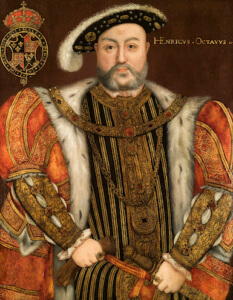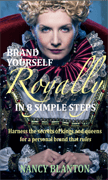Our thanks to personal branding consultant and award-winning author Nancy Blanton for this guest contribution! Here’s how to create an author brand positioning statement you can be proud of:
Like a kid in a candy store, I used to love walking through a large bookstore like B&N. But now, as an author, I think two things and in this order:
- OMG, there are so many books out there. Why even bother writing my own?
- Of all these books, none tell the story I’m telling. I have a purpose and must see it through.
Whatever your genre and inspiration, most of us write with purpose to an intended audience. But how can we reach them in such a sea of colors, titles, expensive posters, ads and gimmicks? The answer is ageless: you must shine like an irresistible gem. You need a personal brand!
 For centuries, kings and queens have used the secrets of personal branding, and not just to define themselves to their subjects. They needed support for policies and taxes, to be likable enough to prevent rebellions or assassination, and they needed to appear strong enough to intimidate other monarchs who might contemplate invasion. What can we learn from them? Plenty.
For centuries, kings and queens have used the secrets of personal branding, and not just to define themselves to their subjects. They needed support for policies and taxes, to be likable enough to prevent rebellions or assassination, and they needed to appear strong enough to intimidate other monarchs who might contemplate invasion. What can we learn from them? Plenty.
Look at one of history’s most notorious kings, Henry VIII, for example. On England’s throne from 1509 to 1547, he was the granddaddy of personal branding, and the perfect model for generating and expressing a memorable persona.
Most people are familiar with the famous Holbein portrait of him standing tall, broad-shouldered, filling up the canvas in his regal robes and codpiece. An icon of strength and robust health, this king gave the people what they wanted: physical power, great wealth, cultural sophistication, grand architecture, athletic supremacy, and a direct link to God.
What you see was not always what you got with King Henry, but he lived in an age without mass communication or the immediacy of social media, so he could get away with projecting an inflated persona that suited everyone’s needs. In today’s world, authenticity rules.
What we learn from Henry is that the strongest brands are built in values that connect with the audience. The power of a brand persona lies in its ability to touch people you may never get to meet.
So, what is a brand persona?
It is a compilation of values, activities and interests that define a person. If you are an author, your work defines you to a great extent, but also the realm in which you work or the subject matter on which you focus.
Add to that your activities. For instance, are you a runner? An equestrian? A motocross enthusiast? Do you love to cook, read, dance?
And then there are societal interests like improving literacy, reducing poverty, protecting the environment, and so on. What keeps you awake at night? What gets you going in the morning? Where would you invest your money to make a difference in the world? Where/how would you donate your time? What are you doing when you are at your best?
Your brand persona cannot include all facets of your life and interests. To be memorable, consider the top 10 that might come up in a conversation with a new acquaintance. You might only have 30 seconds with this person before you shake hands and say goodbye. If he or she were a potential customer, what would you want him/her to remember about you? How would you make that happen?
That’s how a defined persona can help, by clarifying the kernel of you and making it easier to communicate and, therefore, easier to remember. And now we come to the logical next step.
 Brand positioning
Brand positioning
Suppose this person is a fine business prospect, but knows 10 other people who do what you do? How can you rise with distinction to the top of this person’s memory?
Your positioning statement takes all of your values, interests and drives that make you someone worth trusting and doing business with, zeroes in on the places your persona intersects with audience values and needs, and then shoots it to the next level.
Positioning connects you with your audience by capturing the essence of you that is different from (re: better than) anyone else.
Positioning statements are used broadly in brand differentiation. The secret is, you’ve got to get emotional. People make decisions on an emotional level. If you know your own core brand driver—that thing that makes you do what you do—it’s the best place to start.
A personal brand positioning statement is basically a formula that goes like this:
For [insert target audience], [Your Name] is the [insert point of differentiation] among all [insert frame of reference] because [reason to believe].
Here’s a silly example: “For people who need dog walkers, Jane Dogmire is the most lovable and trusted of all dog walkers in the region because she is board-certified by Dogs United and provides homemade peanut butter treats.”
Jane meets the needs of her audience because she can be trusted to do the job right, and will keep the dogs happy, too.
Now, using myself as an example: I write historical fiction and work hard to share what I learn in an entertaining way. I know historical fiction readers like to learn as they read, expect to be entertained, and want high-quality writing. So I wrote my positioning statement like this:
For readers of historical fiction, Nancy Blanton is the award-winning author of Irish history adventure novels, combining in-depth research with a passion for Irish heritage to both inform and entertain.
Note how my values and audience values converge. Words like adventure and passion help tap into the reader’s emotions. Normally, this statement would never be public, but would guide me in creating web content, advertising, marketing collateral, and social communications. In all instances, I could use the same words, or different words that do the same work.
Once you’ve invested the time to define your brand, build your persona and create your positioning statement, most of the heavy lifting for your personal brand is done. These are the guiding forces for the decisions you’ll make writing descriptions of your work, choosing colors and imagery, developing memorable taglines, and so forth.
 Explore the competition
Explore the competition
The next time you go to a bookstore, look at the authors with several titles, and the branding they use. Look at the consistency and subtleties of difference between one of their books and the next. Book A looks similar to Book B. If I liked Book A, then I’ll probably like Book B, so I’ll buy it. What colors and images are other authors in your genre using, and how might you stand out beside them?
The big thing to remember is consistency. Consistency builds trust. Stay true to the elements of your persona and positioning statement. Use the same words over and over. Use your name for your logo, choose a typestyle for it and stick to it. If your persona identifies your interests as horseback riding and cooking, don’t confuse your audience by blogging or tweeting about golf and scuba diving.
Be authentic, be consistent, and you will, over time, build trust. Trust translates into loyal customers—your own beloved audience.
Ready to build your own personal brand positioning statement? Fill in the [ __ ] in the sample above and share it with us in the comments section below!

 Nancy Blanton is author of the RPLA winner for historical fiction, Sharavogue. Her non-fiction book, Brand Yourself Royally in 8 Simple Steps, has become a basis for hands-on personal branding workshops. Her latest novel, The Prince of Glencurragh, publishes this summer. Learn more at nancyblanton.com.
Nancy Blanton is author of the RPLA winner for historical fiction, Sharavogue. Her non-fiction book, Brand Yourself Royally in 8 Simple Steps, has become a basis for hands-on personal branding workshops. Her latest novel, The Prince of Glencurragh, publishes this summer. Learn more at nancyblanton.com.

